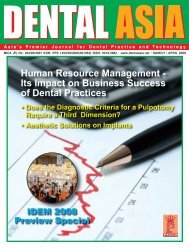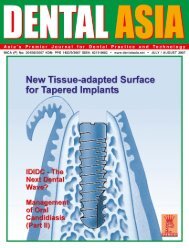Download - Dental Asia
Download - Dental Asia
Download - Dental Asia
Create successful ePaper yourself
Turn your PDF publications into a flip-book with our unique Google optimized e-Paper software.
CLINICALFEATURE<br />
Main Problems in the RPD<br />
(Kennedy Class 1& 2)<br />
Instability<br />
The mandibular free-end distal extension RPD rests on both<br />
fixed and soft tissues.<br />
Consequently the RPD tends to<br />
rotate around a single place and<br />
move down on the soft<br />
underlying tissues. In a distal<br />
extension RPD case with one or<br />
more anterior teeth missing, the<br />
anterior part goes down as the<br />
posterior part goes up and vieversa:<br />
this is the “teeter-totter<br />
phenomenon. (Figure 1)<br />
Figure 1 (top & bottom) Lateral<br />
and horizontal movements of the<br />
frame<br />
Rocking can not only occur in a<br />
vertical plane but often also in a<br />
horizontal plane causing the wellknown<br />
internal posterior soars<br />
(Figure 2). RPD instability will<br />
develop unbalanced forces that<br />
will have consequence to slowly<br />
mobilizing the supporting teeth<br />
until they have to be pulled out. 4<br />
Usually the new missing teeth is<br />
already replaced and the clasp<br />
displaced to the next proximal<br />
teeth; increasing in this way the<br />
distal extension span, “a domino<br />
effect”.<br />
Carious Destruction of the Abutments<br />
Only a few of the most carious resistant teeth can survive the<br />
environmental changes brought by the presence of a clasp-type<br />
ackers and the constant food impaction between the saddle –<br />
guiding plane and the distal aspect of the teeth. (Figure 3)<br />
Destruction of Abutments by<br />
Periodontal Diseases<br />
A well known fact is the destructive potential of a RPD as<br />
consequence of the amplitude of the denture movement and<br />
the clasp mechanism which transfer these movements toward<br />
the abutment teeth. This suggests our analysis about the<br />
denture basis and its relationship to the denture instability. 5<br />
1. The Soft Tissue Support.<br />
Especially in the large distal extension cases, a very large<br />
mucosal support is recommended in order o provides the<br />
widest support under the saddle. The inaccuracy of the cast by<br />
a simple alginate impression, or an inadequate functional<br />
impression would produce negative consequences on the<br />
fitness of the final acrylic basis. (Figure 4)<br />
2. Altrough with good<br />
impression both anatomic<br />
and functional of the basis<br />
by the “altered cast<br />
technique “they are slight<br />
movement in function<br />
before that the basis<br />
reaches the rock-bottom<br />
of incompressibility of the<br />
soft underlying structures.<br />
Such kinds of movement<br />
in a simple clasp RPD<br />
drops the basis onto the<br />
soft tissue not in a<br />
simultaneous vertical<br />
drop, BUT act as a hinging<br />
mechanism or fulcrum<br />
around which the denture<br />
tips down in distal part and<br />
up in the mesial part.<br />
Stress breakers,<br />
Stress Equalizers,<br />
Trauma Absorbing<br />
Figure 2 (top & bottom) Internal<br />
Posterior lingual soars area<br />
These devices are promoted on the fact that they should allow<br />
to the denture basis to move slightly without straining on the<br />
abutment. There are mainly two types of stress-breakers:<br />
A. The most commons are the hinge type stress-breakers<br />
(Figures 5a & 5b). This concept provide a disarticulation<br />
between the basis and the retentive apparatus (clasp and<br />
precision attachment), but act only on vertical occlusal forces,<br />
they have no incidence in the lateral occlusal movements. 6<br />
B. Other stress breakers like the ball-and-socket type allow<br />
essentially the same tipping action and add to it lateral mobility<br />
which tends to allow lateral or rolling mobility and also some<br />
bucco-lingual rolling. (Figures 6a & 6b)<br />
In the two cases, the problem remain in terms that the stressbreaking<br />
leaves the denture basis in much the same situation<br />
with a fulcrum acting a few millimeters distally and much freer<br />
in its movement because the absence of retentive clasps. In<br />
addition this type of device allows an excessive space for the<br />
vertical drop and causes infra-occlusion on the posterior teeth<br />
and consequently an overloading of the anterior remaining<br />
teeth. Taking into the consideration the severe bone resorption<br />
in senior patients, this will be a major weakness of the system.<br />
(Combination Syndrome) (Figure 7a)<br />
The sequel of this action in particularly when bone resorption<br />
frequently occurs, is the continuing rocking of the denture when<br />
loaded occlusally. The rests of the last abutment are in this<br />
case acting as fulcrums. This phenomena establishes a selfperpetuating<br />
or rather a self-worsening situation where more<br />
36 <strong>Dental</strong> <strong>Asia</strong> • May / June 2008





